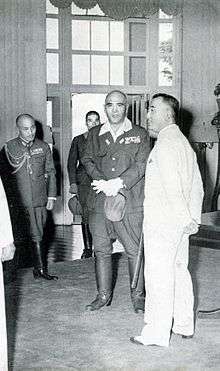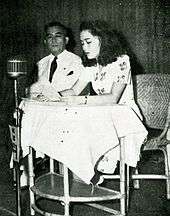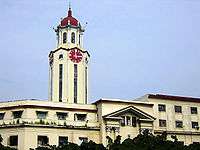Jorge B. Vargas
| Jorge B. Vargas | |
|---|---|
 Vargas (in white) with Japanese General Homma, 1943 | |
| Presiding Officer of the Philippine Executive Commission | |
|
In office January 23, 1942 – October 14, 1943[1] | |
| Governor-General | Masaharu Homma |
| Preceded by |
Himself As Head of the Civilian Emergency Administration |
| Succeeded by | José P. Laurel (as President) |
| Head of the Civilian Emergency Administration In concurrent capacity with the mayoralty of Manila | |
|
In office December 22, 1941 – January 23, 1942 | |
| Appointed by | Manuel Quezon |
| Succeeded by |
Himself As Presiding Officer of the Philippine Executive Commission |
| Ministries involved | |
|
In office October 14, 1943 – August 17, 1945 | |
| President | José P. Laurel |
| Preceded by | Pedro A. Paterno (as Prime Minister) |
| Succeeded by | Ferdinand E. Marcos (as Prime Minister) |
| Mayor of Manila In concurrent capacity with the headship of the Civilian Emergency Administration | |
|
In office December 22, 1941 – January 23, 1942 | |
| Appointed by | Manuel Quezon |
| Preceded by | Valeriano Fugoso |
| Succeeded by | Leon Guinto, Sr. |
| Secretary of National Defense | |
|
In office December 11, 1941 – December 22, 1941 | |
| Appointed by | Manuel Quezon |
| Preceded by |
Manuel Quezon in concurrent capacity as President |
| Succeeded by | Basilio Valdez |
| Executive Secretary | |
|
In office January 30, 1936 – December 11, 1941 | |
| Appointed by | Manuel Quezon |
| Preceded by | Post created |
| Succeeded by | Manuel Roxas |
| Vice Mayor of Manila | |
|
In office January 1, 1934 – January 4, 1940 | |
| Appointed by | Manuel Quezon |
| Preceded by | Honorio Lopez |
| Succeeded by | Hermenegildo Atienza |
| Personal details | |
| Born |
Jorge Bartolome Vargas August 24, 1890 Bago, Negros Occidental, Captaincy General of the Philippines |
| Died |
February 22, 1980 (aged 89) Manila, Philippines |
| Political party | Kapisanan ng Paglilingkod sa Bagong Pilipinas |
| Spouse(s) | Marina Yulo & Adelaida Montilla Peña |
| Mother | Filomena Trinidad Celis |
| Father | Angel Tiongco Vargas |
| Religion | Roman Catholic |
Jorge Bartolome Vargas[2] (August 24, 1890 – February 22, 1980) was a lawyer, diplomat and youth advocate born in Bago, Negros Occidental, Philippines. He graduated valedictorian from Negros Occidental High School in 1909 and obtained a Bachelor of Arts degree in 1911 and a Bachelor of Law degree with honors in 1914, both from the University of the Philippines. He was a founding member of the Philippine Amateur Athletic Federation (now the Philippine Olympic Committee) in 1911 and served in its Executive Committee in 1918.[3] He served as its second Chairman from 1935 to 1955. He was also the first Filipino member of the International Olympic Committee.[4]
Government service
After being admitted to the Philippine Bar in 1914, he was appointed as law clerk in the Philippine Commission. He quickly rose through the ranks and was promoted to the position of Chief Clerk of the Department of the Interior in 1917.[5]
In 1918 he served as the legislative secretary to Speaker Sergio Osmeña of the House of Representatives and in 1936 was appointed by President Manuel L. Quezon as his Executive Secretary, becoming the first in the country to serve in such a position.[6]
When the Japanese invaded the country in 1941, Vargas was designated to the Department of National Defense as its secretary. A few weeks later, he was appointed by President Manuel Quezon as mayor of the Greater Manila area in 1941. His responsibilities included administering the open city upon the arrival of occupational troops of the Imperial Japanese Army on January 2, 1942.
By 1942, Vargas became chairman of the Japanese-sponsored Philippine Executive Commission. During the collaborationist Second Philippine Republic, he was once asked by the Japanese to assume the Presidency, but he declined. He instead served as the regime's Ambassador to Japan. In that position, he was quoted shortly before Japanese troops were driven from Manila as stating that "we know Japan is destined for sure victory and prosperity for ages to come."[7]
Vargas served as Chairman of the National Planning Commission from 1946–1954 and was a member of the Board of Regents of the University of the Philippines from 1961-1965. In 1960, the Republic of the Philippines conferred on him the Legion of Honor with the rank of Commander.[3]

Scouting
Vargas' involvement with Scouting started in 1935 when he became a member of the executive board of the Philippine Council of the Boy Scouts of America. Together with other Philippine Scouting advocates he became one of the charter members of the Boy Scouts of the Philippines in 1936.[3]
Upon the death of Manuel Camus in 1949, Vargas was unanimously chosen by the National Executive Board to serve as the BSP's President and Chief Scout of the Boy Scouts of the Philippines. He served the position of National President until 1961. He became a member of the World Scout Committee of the World Organization of the Scout Movement from 1951 to 1957.
Vargas was awarded the Bronze Wolf in 1959 and received other awards including the Silver Tamaraw (Philippines), Silver Fox (Canada), Silver Ibex (Austria), Silver Wolf (UK), and in 1959 also received the highest distinction of the Scout Association of Japan, the Golden Pheasant Award.[8] He also became the first recipient of the Tanglaw ng Kabataan (Light of the Youth) Award of the BSP in 1961.[3]
Honours
 Japan: Grand Cordon (1st Class) of the Order of the Rising Sun (October 1, 1943)[9]
Japan: Grand Cordon (1st Class) of the Order of the Rising Sun (October 1, 1943)[9]
See also
References
- ↑ Appointed by Manuel L. Quezon, December 30, 1941 as Head of the Civilian Emergency Administration; then appointed by Masaharu Homma as head of government, January 23, 1942
- ↑ The Jorge B. Vargas Art Collection as a Microcosm of Art during the Commonwealth - page 4: "Jorge Bartolome Vargas (1890-1980) became well known..."
- 1 2 3 4 On My Honor, Boy Scouts of the Philippines, 2001, p. 136-137.
- ↑ "Philippine Olympic Committee". Olympic.ph. Retrieved 2012-09-11.
- ↑ "Philippine Department of Defense". Dnd.gov.ph. Retrieved 2012-09-11.
- ↑ Jorge B. Vargas Museum
- ↑ "Japan is warned by puppet envoy of Manila's fate," Oakland Tribune, p. 2D, 1945-02-03.
- ↑ reinanzaka-sc.o.oo7.jp/kiroku/documents/20140523-3-kiji-list.pdf
- ↑ "Filipino recipients of Japanese decorations and Japanese recipients of Philippine decorations". Official Gazette of the Republic of the Philippines.
| Preceded by Masaharu Homma Japanese Military Administration |
Presiding Officer of the Philippine Executive Commission (de facto Head of Government) January 23, 1942 – October 14, 1943 |
Succeeded by Jose P. Laurel President of the Philippines |
| Preceded by Pedro A. Paterno Prime Minister of the Philippines |
Ministries involved October 14, 1943 – August 17, 1945 |
Succeeded by Ferdinand E. Marcos Prime Minister of the Philippines |
